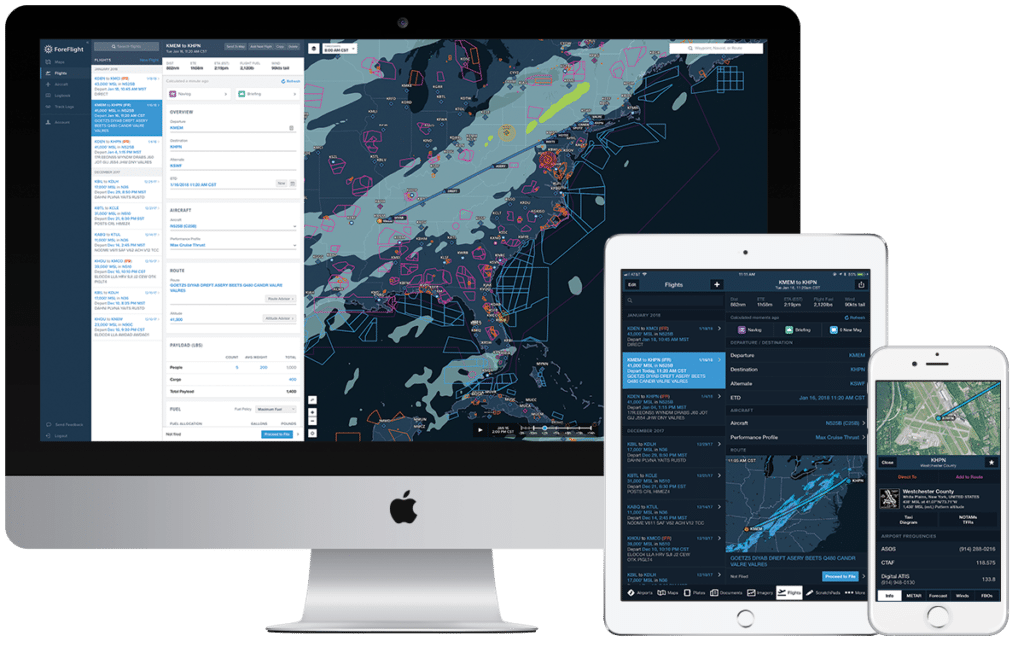
ForeFlight planning on mobile and web. Image courtesy of ForeFlight
Since ForeFlight launched in 2007 on the eve of the iPhone revolution, the company’s star has continued to rise, and today, it is the aviation industry’s undisputed go-to app for situational awareness in the cockpit.
From the beginning, co-founders Tyson Weihs and Jason Miller have had their share of surreal, pinch-me moments.
They just added another memorable milestone to their list this month when they received the Living Legends of Aviation Entrepreneurs of the Year Award in Beverly Hills, California.
“It’s both humbling and surreal,” said Weihs, ForeFlight CEO, who quickly credited the company’s 130 employees for the recognition. “We are just two people, but it’s a team that makes this happen.”
Avionics caught up with Weihs, who shared his thoughts on the industry, his company and the key areas his team of engineers and private pilots are most excited about as they look to develop more intuitive tools to enhance pilots’ flying experience.
What do you consider the single biggest impact ForeFlight has had on the aviation world?
We have transformed the way pilots access information in the cockpit and we think that has led to a measurable improvement in safety. The AOPA’s Joseph T. Nall report talks about decreases in weather-related incidents. A 21% drop in weather-related in-flight incidents in general aviation in 2013 was followed by a further 22% decrease in 2014. It’s related to both tablets and apps in the cockpit and ADS-B.
If you look over the past 10 years or so, the number of TFR incursions have started to go down as well. It’s very easy to get equipped with data-linked weather, subscription free. Information can be presented automatically to a pilot based on what’s going on. So pilots are much more efficient when they plan — they are much better informed, and they are safer as a result.
What are the latest product innovations coming out of ForeFlight?
One area we are very interested in is automation — presenting information that pilots need at the right time and being more predictive and anticipatory of what they might want to know or get at any point in time. A simple example: the app detects where the pilot is relative to a destination airport and automatically presents ATIS frequency information at the right time. That triggers an action to tune into the frequency for the weather.
Typically, in the past you had a checklist item to do before descent and then you had to go look up that information. It reduces the number of steps you need to execute in the airplane.
There’s a lot of talk about artificial intelligence (AI) and machine learning. Those technologies basically allow you to create algorithms that leverage data like sensor data on the iPad or flight planning data or a pilot’s usage patterns. AI helps you tune the application for that particular user. So, we look at things like machine learning to help identify flight segments — are you in a climb, in a cruise, are you doing laps around the pattern? With advances in those areas, we can leverage that technology to help improve the user experience and present information contextually.
Your new product Scout, which provides ADS-B weather and flight-planning information in one unit, is an example of a product being offered in a smaller form factor for a lower cost.
Advances in circuits and semiconductors help drive the size of these units and the cost down. Aviation is benefiting from the advancements that phone manufacturers have driven. Every phone now has a barometer in it. It has a nine-axis autopilot and a pressure sensor. It has a GPS chip. All these little circuits are helpful in aviation. Because they have made billions of phones, the cost of those parts has gone way down. We enjoy lower cost access to components that are higher quality.
For $200 [for Scout], a pilot can get access to all the essential airport information they need as well as datalink weather. Those things were out of reach when I started to learn to fly in 2002. I recall my first cross-country flight with an early GPS navigator. Not knowing what the weather was going to be like en route and when I got to location created anxiety. Now with as little as $100 for ForeFlight and $200 for an ADS-B receiver, you have professional-grade information available to any pilot.
What’s on the horizon next for your company in terms of future roadmaps?
We like to surprise customers so we don’t talk a lot about the specific features we have in development, but the theme of automation is on our minds. This theme of simplifying flight planning — you as a pilot taking fewer steps to get a flight plan computed — is interesting.
Any final thoughts on your outlook for the future both for your company and the industry as a whole?
We have just as much excitement about what we can deliver to pilots for the next 10 years as we had in the first 10 years. There is a lot of innovation left to be delivered to pilots. We feel we are at the beginning of this opportunity to deliver essential technology, capabilities and benefits to pilots over the next decade.